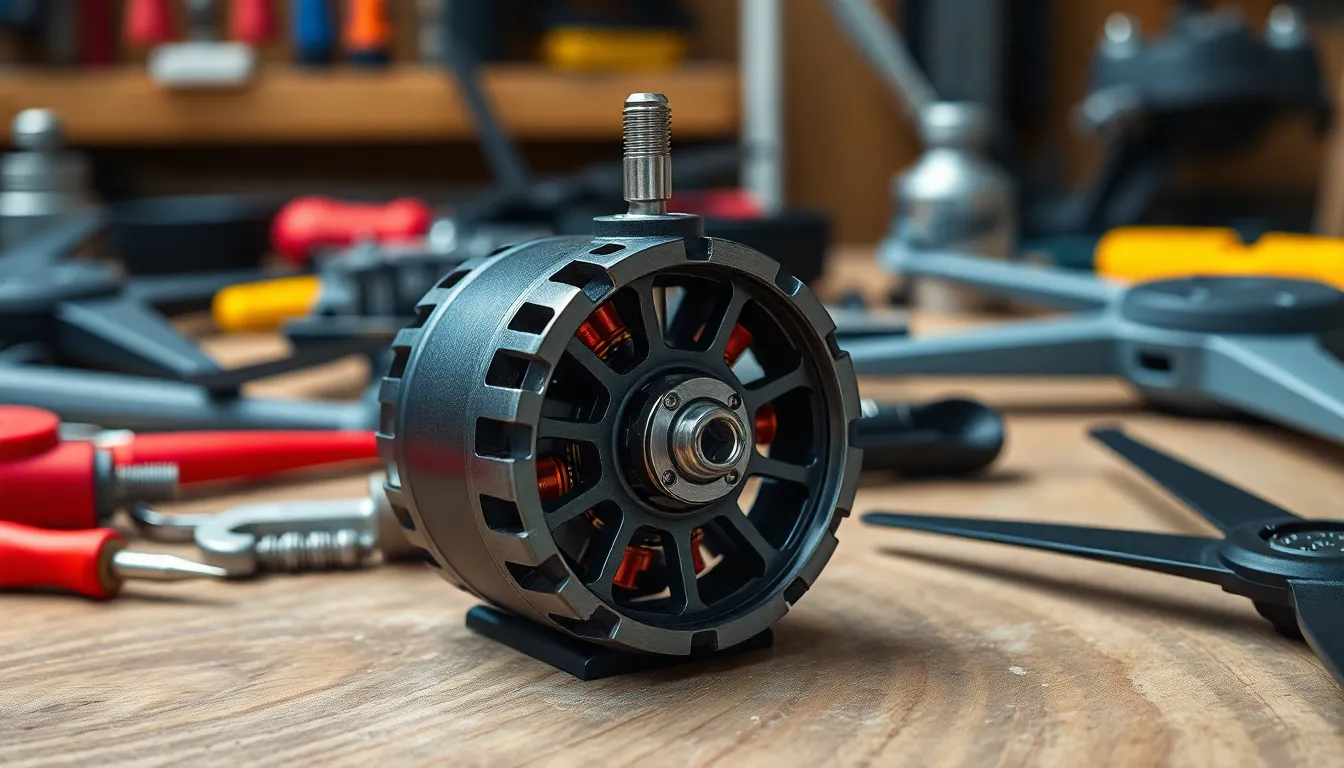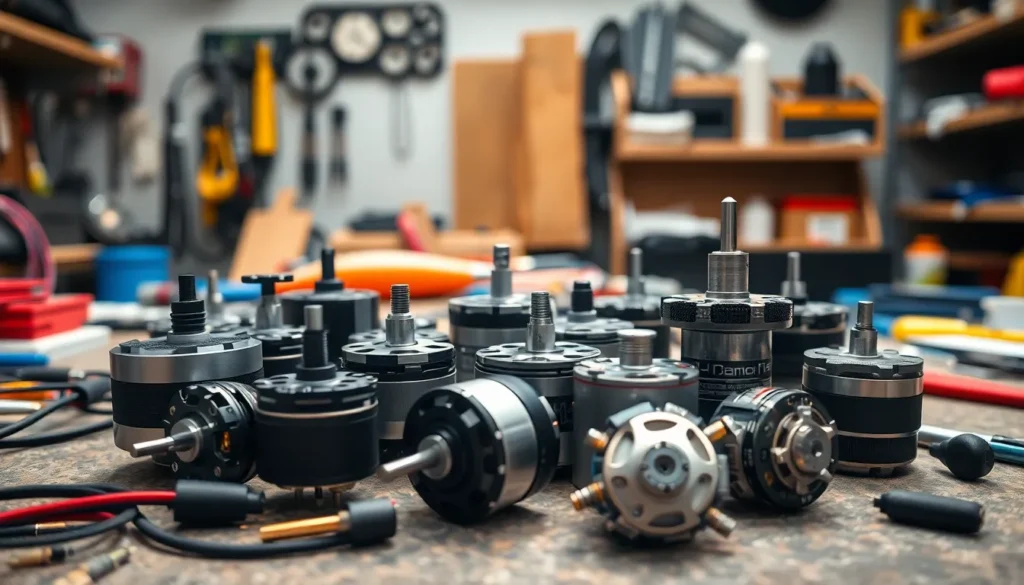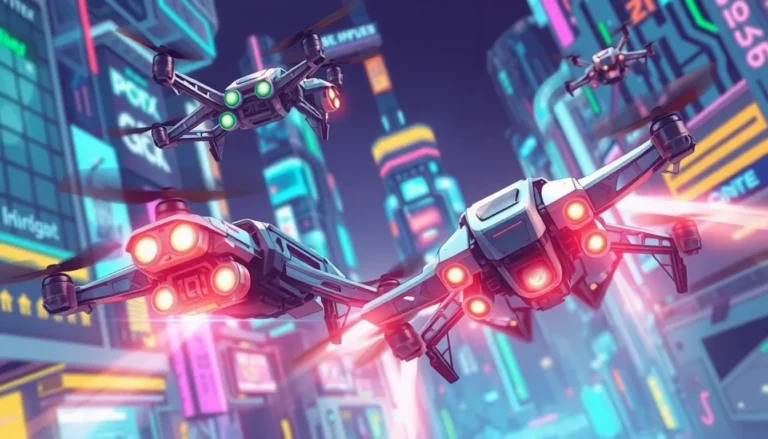Table of Contents
ToggleIn the world of drones, the motor is the unsung hero, powering the aerial acrobatics that leave spectators in awe. Whether it’s a high-flying racing drone or a sturdy quadcopter capturing breathtaking landscapes, the type of motor can make or break the experience. But with so many options out there, how does one choose?
Overview of Drone Motor Types
Electric motors dominate the drone market due to their efficiency and ease of use. Brushless and brushed motors represent the two primary types.
Brushless motors offer several advantages. These motors provide higher power-to-weight ratios, better efficiency, and longer lifespan compared to brushed alternatives. Many racing and high-performance drones utilize brushless motors to achieve optimal flight characteristics.
Brushed motors, though less common, still find applications in specific contexts. They tend to be simpler and less expensive. These motors suit beginner drones and toy models well, where the demands aren’t as stringent.
In addition to type, motor size plays a significant role. Motors are available in various sizes, measured in millimeters, impacting thrust and performance capabilities. Smaller motors fit compact drones, while larger motors suit heavy-lift models.
Thrust-to-weight ratio serves as another critical factor. Higher ratios enable better acceleration and maneuverability during flight. Pilots often calculate this ratio to optimize performance based on their desired use case.
Additionally, motor KV rating merits consideration. The KV rating indicates the motor’s RPM per volt. Higher KV values typically suit racing drones, while lower values often benefit more stable flight in aerial photography drones.
Understanding these motor types and specifications aids in making informed choices when selecting drone motors. Each motor type brings unique attributes, catering to diverse flight experiences and requirements.
Brushed Motors

Brushed motors serve as a practical choice for many beginner drones and toy models. These motors consist of a simple design that requires less technical knowledge for operation.
Advantages of Brushed Motors
Affordability stands out as one key benefit. Brushed motors typically cost less than their brushless counterparts, making them accessible for novice drone enthusiasts. Simplicity in design ensures straightforward installation and maintenance. Easy repairs add to their appeal, as replacements are conveniently available. Adequate performance suits low-speed applications like beginner drones and toys. They also deliver decent thrust, which can be satisfactory for casual flying experiences. Lower weight enhances overall drone agility, making these motors effective for lightweight builds.
Disadvantages of Brushed Motors
Brushed motors carry certain limitations. Inefficiency often leads to higher energy consumption compared to brushless models. Short lifespan emerges as another drawback, since wear and tear increase with extended use. Frequent replacement typically becomes necessary for sustained performance. Heat generation during operation contributes to potential motor failure, affecting reliability. Reduced power-to-weight ratio compares unfavorably to brushless motors, affecting acceleration and maneuverability. Overall, these factors can restrict performance in demanding flight scenarios, making brushed motors less suitable for advanced applications.
Brushless Motors
Brushless motors serve as the preferred choice in drone technology due to several key performance indicators. Their design contributes to superior efficiency and longevity compared to other motor types.
Advantages of Brushless Motors
Higher power-to-weight ratios make brushless motors ideal for racing and demanding aerial applications. Improved efficiency translates to better battery performance, allowing longer flight times. Longevity stands out as a significant benefit, with these motors often lasting several hundred hours of use without requiring replacement. Less maintenance is needed since there are no brushes to wear out, resulting in reduced upkeep costs. Enhanced responsiveness offers greater control, which is essential in competitive environments. Additionally, quieter operation contributes to less noise pollution, a crucial aspect for capturing quality visuals in photography missions.
Disadvantages of Brushless Motors
Higher initial costs often deter new drone enthusiasts from choosing brushless motors. More complex electronic speed controller systems are required, which complicates setup and increases weight. Some users find the performance characteristics challenging, particularly in low-speed applications. Customization options may limit those looking for simple plug-and-play solutions. Troubleshooting can be difficult for beginners, who might lack the requisite technical knowledge. Installation typically requires more precision, making it less forgiving for novice builders or hobbyists.
Comparison of Brushed and Brushless Motors
Brushed and brushless motors serve distinct purposes within the drone market. Brushed motors are simpler in design and lower in cost, making them accessible for beginners and toy models. They offer decent performance for applications that don’t demand high speeds. Commonly, users appreciate their ease of maintenance.
On the other hand, brushless motors excel in efficiency and performance. They feature a higher power-to-weight ratio, which translates to better acceleration and flight capabilities. Owners of racing drones and high-performance models often opt for brushless motors because of their advanced responsiveness and longevity. Lifespans can range from several hundred hours, reducing the frequency of replacements.
Weight plays a significant role in motor selection. Brushed motors tend to be lighter, adding agility for entry-level drones. Comparatively, brushless motors, although heavier, provide substantial thrust, essential for larger or more advanced drones.
Efficiency shows notable differences between the two types. Brushed motors may struggle with energy consumption in demanding scenarios, leading to shorter flight times. Conversely, brushless motors optimize energy use, resulting in longer flights and improved overall performance.
Cost also influences decisions. Brushed motors, being more affordable, attract users on a budget. Brushless motors involve higher upfront costs, yet their reduced maintenance needs prove beneficial over time.
Understanding these differences assists in selecting the appropriate motor for specific drone applications. Those seeking high-speed racing or multifaceted aerial photography often favor brushless models, while beginners may find brushed motors sufficient for learning and development.
Specialty Motors
Specialty motors play a unique role in various drone applications, enhancing performance and functionality based on specific requirements. Two notable types include stepper motors and coreless motors.
Stepper Motors
Stepper motors provide precise control over movement, making them ideal for applications requiring accuracy, such as gimbals. These motors operate by dividing a full rotation into smaller steps, which allows for incremental positioning. This feature is crucial in scenarios where stable camera footage is necessary. While stepper motors may lack the high speed of other motor types, their reliability and ability to hold position without power make them suitable for specialized drone functions. Users appreciate this consistency in applications like surveying and cinematography, where every detail counts.
Coreless Motors
Coreless motors feature a unique design that eliminates the iron core, resulting in reduced weight and improved speed. The lightweight structure enhances responsiveness, making these motors suitable for agile drone designs. Coreless motors can accelerate rapidly, which is beneficial for racing and dynamic aerial maneuvers. While they deliver significant power, users often note that they can generate less torque compared to other motor types. Drones equipped with coreless motors offer an excellent balance between speed and weight, catering to enthusiasts focused on high-performance flying experiences.
Selecting the right drone motor is essential for achieving optimal performance and meeting specific flying needs. With a variety of options available from brushed to brushless motors and specialty types like stepper and coreless, understanding their unique characteristics can greatly enhance the flying experience.
For beginners, brushed motors offer an accessible entry point with their simplicity and affordability. In contrast, advanced users benefit from the efficiency and power of brushless motors, which excel in demanding scenarios.
Ultimately, knowing the differences in motor types and specifications empowers drone enthusiasts to make informed decisions that align with their goals, whether for casual flying or competitive racing.







